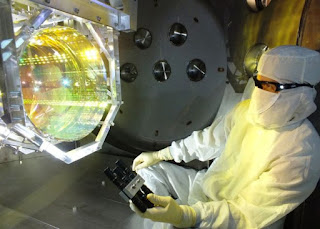Labs in the US state of Washington and Louisiana began
detecting on Friday for the gravitational waves that are predicted to flow
through earth when violent events in the universe occur.
The advanced Ligo facilities have just completed a major upgrade;
scientists believe it will now give them the sensitivity needed to pick up what
should be very subtle signal.
Kip Throne, a theoretical physicist, one of the pioneers
behind the experiment, went so far to say, it would be quite surprising if the
labs made no detection.
Gravitational waves are a prediction of Einstein’s Theory of
general relativity. They describe the wrapping of space-time that occurs when
masses accelerate.
But their expected weakness means only astrophysical
phenomena on a truly colossal scale are likely to generate waves that will
register on even the remarkable technologies assembled at Hanford in the
American northwest and at Livingston in the southeast.
Sources that Advanced Ligo might observe include merging
black hole and neutron stars and with luck some exploding giant stars.
Gravitational waves are inevitable consequence of the theory
of General Relativity, their existence has been inferred by science but not yet
directly detected, and they are ripples in the fabric of space-time produced by
violent events.
Accelerating masses will produce waves that propagate at the
speed of light, detectable sources ought to include merging black holes and
neutron stars. Detecting the waves opens up the Universe to completely new investigations.
The technique being used is laser interferometry. Both Ligo
labs works by splitting a light beam and sending the two halves down separate,
4 KM-long evacuated tunnels.
The beams are bounced back and forth by mirrors before being
recombined at their starting point and sent to detectors.
If the delicate gravitational waves pass through the set-up,
the laser light should show evidence of having been ever so slightly disturbed-
either lengthened or shortened.
Advanced Ligo is looking for changes in laser-arm distance
that are on the order of one-thousandths of the width of a proton.
The equipment’s peak sensitivity will be to waves with a
frequency of around 100Hz, which in auditory terms is at the low end of what
humans can hear. And it is for this reason that gravitational wave detection is
often described as trying to pick up sounds of the cosmos.
“These detectors are
like microphones where we’re listening to the Universe,” said Jamie Rollins
from California institute of Technology, one of the project’s lead institutions, it’s like we’ve been deaf to the Universe until now.
Scientists must now wait for the Universe to comply – for the
two black holes to spiral into each other, or, perhaps for supernova to go off
in our Milky Way galaxy.
Supercomputers will be sifting constantly the data patterns that
match the expectation of the simulations. Even for those signals that stand out
as so unexpected they may hint at something that goes totally beyond current
understanding.
Credit: BBC Technology.

No comments:
Post a Comment